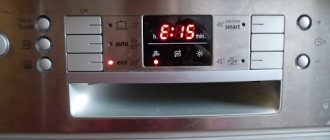I have a Bosch MCM 2100/02 food processor.
We have been living together for five to seven years, I don’t remember exactly. I love it because it performs almost all the operations I need and takes up very little space. The photo shows its size compared to the bread maker.
Recently, grief befell me; it burned down. Or rather, it didn’t stop working, but it started to smell like burnt plastic. We took it to the service center (thanks to Nastya, I wouldn’t have done this myself given my circumstances), they looked at it and said that the engine needed to be changed, the cost of repairs was 950 UAH!
To my persistent questions “did the motor, rotor winding, etc. burn out?” the master answered vaguely, only hinting that the brushes were burning.
Somewhere in the depths of my soul I was ready to pay for its repair, just to bring it back to life, but I understood in my head that for this money I could buy a new one. My husband was categorically adamant that we would not repair it.
So we picked it up from the service center and decided that before throwing it away, we’d take it all apart and take a look. We even considered the option of rewinding the rotor if it was burnt out.
They opened it. We were very surprised. Everything was intact there! My husband rang the entire winding and checked the microcircuit. The motor is alive and pristinely clean!
There was only one problem - the brush was worn out and was not pressed tightly by the spring to the rotor winding, which created additional resistance there and the plastic got very hot (that’s why it stank).
Is it really necessary to replace the entire engine because of such a trivial breakdown? Anyone who has encountered electric motors will understand me.
For those who don’t know what it is, I’ll explain a little.
A brush is a piece of graphite that is pressed against the rotating rotor shaft and transmits current to it. The size of this brush is approximately 2x1x0.7 cm. Graphite is a soft material, it wears out quickly and therefore the brushes are periodically replaced.
DIY food processor repair
Today, food processors from Bosch and many other manufacturers have become almost indispensable devices in the kitchen. There are various modifications of these units that allow you to perform various tasks without you making any special efforts. For some housewives they have become very important, and any breakdown in the system becomes a serious problem. In this article we will tell you about the structure of the device and how to repair food processors with your own hands.
Structure of a typical food processor
DIY food processor repair requires knowing the basics. It's easy inside. The well-worn phrase on the site is once again appropriate. A food processor is designed to do what a hand blender with a bowl attachment with knives can do today. Functions include preparing cocktails. Translated into Russian it means: there are three devices that intersect each other, only the last one will replace everything:
- hand blender;
- tabletop blender;
- food processor.
Let's critically evaluate the capabilities of the food processor. Two drives:
- For a straight blender.
- For grinding with a gearbox through a belt or gear drive.
A KitchenAid food processor cannot be distinguished from a blender; once you remove the attachment, we are not considering the simplest options today. So, there are two drives, each rod for its own purposes. It is made straight for a blender, which is not at all surprising. The attachment often grinds ingredients, creating significant loads that cannot be transferred through a belt. The second drive of the food processor is really interesting, where the shredding and grater attachments are located. There is a movable clutch here that, when pressed, turns off the rotation. Let’s say in advance: in the electrical circuit there is a whole bunch of push relays that cut off the power to the device if protective caps are not installed. Of course, the defense can be fooled.
I'm pleased with the simplicity of the circuit design. At the input of the electronic board there is a painfully familiar RC-chain filter, from where one wire supplies the motor, the second passes through a triac circuit for adjusting the input current.
The speed is adjusted. Let us describe the action of the scheme:
- Power is supplied to a triac operating in linear mode. The key element is equipped with a decent-sized heatsink that dissipates excess heat.
- The control electrode receives a voltage divided by a variable resistor, the motor's feedback is a parasitic EMF that occurs when switching collector sections with a rotating shaft.
- The speed controller rotates, the variable resistor changes the value of the control voltage of the triac electrode. The turnover increases or decreases.
- The load on the engine increases, the rotor slows down. The value of the parasitic back EMF of the collector drops, the voltage of the control electrode of the triac changes, and the consumed current begins to increase. Subsequently, the speed increases again, the engine reaches the specified mode.
A simple self-regulation circuit; from an electrical point of view, there are no complaints about Philips. Well done. Not counting the fifth conductor coming out of the engine, coming to the board, remaining hanging in the air. However, these are small things compared to the Torx screws screwed into the plastic – they are fake. A two with a minus: the buyer is being cheated by bad manners. The circuit is devoid of fuses, thermal protection is abundant. It honestly says on the winding that a fuse with a threshold of 135 degrees Celsius is hidden inside. There is another one nearby, reusable. One thing is striking: the power comes out of the board, goes to the motor, and the rotor-stator section is closed on the board. It’s difficult to say why this is being done.
The device is considered simply as two and two. Therefore, it is easy to repair your food processor. Let's see the order.
Food processor device
The device consists of individual elements of the mechanism, the most basic elements are as follows:
- Electrical engine;
- receiver of processed products;
- chamber for processing ingredients;
- sets of attachments and knives;
- main combine control panel;
- electrical wiring connecting the main elements.
The body material of combine harvesters is usually made of plastic. However, all other parts, such as nozzles, knives and other elements, are made of stainless steel, since it is durable, and it is the internal parts of the device that bear the greatest load.
See also -
5 best food processors with meat grinder based on customer reviews
Design and types
To successfully use these devices in everyday life, it is enough to know the purpose of their main components. But for successful repairs, knowledge of the internal structure of the equipment and a diagram of the food processor, which is usually attached to the operating instructions for the equipment, will be useful.
All combines are divided into 3 main types:
- mini devices;
- compact products;
- multifunctional units.
The latter type includes devices that have a combination of a meat grinder and a juicer, but the operating principle of all types of combines is completely identical. For example, the Mulinex company produces compact combines with a nice design and easy disassembly for washing; they have an interface that is understandable for any housewife. The Ladomir food processor has an attractive design, and the price is much lower than that of imported similar products. Model 408 is equipped with the latest technologies that allow the housewife to prepare any, even the most complex, dish.
The main elements of any combine, regardless of the manufacturer, include:
- electric motor;
- special device for processing various food products;
- chambers designed to process various ingredients;
- set of attachments, discs and knives;
- main panel, with keys for controlling processes;
- electrical wiring to connect all elements.
The body of such products is made of fairly durable plastic, and sets of knives and disks for cutting vegetables are made of stainless material, a special grade of steel.
For example, the Mriya 2M food processor is made of materials that are used in the construction of domestic rockets, which indicates the high quality and durability of such a product.
Food processor Mriya 2M
Main causes of problems
Combines are divided into several types:
The last type of combines are those in which, for example, there is a combination of a meat grinder and a juicer. However, despite their different functional features, they all have the same operating principle.
After loading the products into the working chamber of the combine, they are brought to the desired state according to a given program. Processes can change by replacing attachments on them and giving the device the necessary commands. The nozzles are driven by an electric motor. Understanding that your food processor requires urgent attention is quite simple:
- new sound effects that the device has not previously produced, for example, squeaks, knocks, rattles and others like them;
- you feel an unpleasant smell of burning wiring coming from the machine;
- cracks and chips have formed on the nozzles;
- the unit begins to work at an uneven pace, or it does not work in the correct mode according to the given program;
- the device does not want to activate and start working.
As for the torque transmission part, some combines use a belt drive to transmit torque to the main working parts. When the device begins to work poorly, it may be time to replace the worn belt. There is also a keyed transmission of torque forces; in this case, the key may wear out, which will also lead to the inoperability of the combine.
There are many variants of combine harvester malfunctions; perhaps some of its internal elements may fail; if one part fails, the entire mechanism may break. There are also cases when problems arise in the wiring of the unit itself, when a short circuit occurs.
The combine is faulty - what to do?
Any owners will sooner or later have to repair their food processor themselves. Before you disassemble your food processor, check to see if it is still under warranty after purchase. If there is one, then it is best to take the unit to a service center so that they can provide the necessary maintenance and return the combine to its functionality.
But as happens in most cases, breakdowns occur after the end of the warranty period; here it’s worth trying to disassemble and repair the Bosch food processor before going and sending it in for repair, where they will charge you a lot of money for repairs.
First of all, we disassemble the food processor, but remember well where you removed it and unscrewed it from, since you will have to put the unit back together. All actions boil down to the following:
- turn off the device from the power supply and remove all removable parts;
- remove the combine itself and make sure the integrity of the belt and drive gears;
- remove the above elements and remove the engine. Inspect it for integrity and performance;
- Remove the protective cover from the gearbox and check the drive shaft for signs of defects.
If you have a different model, you can easily find videos and detailed instructions on the Internet.
When you are going to buy a replacement for a part, be sure to take the original ones, since third-party ones simply will not be able to easily fit into the groove. You can purchase such items at special service centers, or order them online.
The procedure for inspecting and repairing a combine harvester
It is necessary to inspect the product in order to find a failed part by following a certain sequence of actions. Electrical inspection is carried out as follows:
- First of all, you need to assess the condition of the wire - make sure it is intact, there are no kinks, melting or other damage. To check that voltage is passing through the cord, you should use a special tester.
- With a normal value of 230 V, the voltage difference at the input and output should be 230 V; to check, the input filter capacitor is rung.
- When performing the test, you will need to bypass the protective relay, since the voltage supply is blocked by the switches. In the off state, the circuits are closed to achieve the voltage of the thyristor.
- The rheostat forms a control circuit; one end is the phase and the other is ground. Next, remove the control potential from the control contact and measure the voltage between the ends. It is important to ensure that the control signal pickup is successful.
- The steps described will make it possible to determine whether the wiring is working properly and whether there is any electrical damage. In conclusion, it is better to check the value of the motor control voltage while simultaneously tightening the rheostat. The amplitude must change.
- If a motor breakdown is detected, you need to check the thermistors and ring the winding. You can start the engine directly from 230 V to evaluate its functionality - the device should work at maximum speed.
- By turning the shaft manually, the commutator winding rings.
Healthy!
A broken rheostat begins to crumble, the device does not work in all modes, and gear shifts are jerky. Checking the belt shaft from the mechanical side looks like this:
- Check to see if the belt is slipping.
- Is the clutch OK?
If the belt is a part similar to a car belt, that is, not an ordinary rubber band, but a complex element with teeth the size of a gear, this indicates its durability. Replacing a dried out, frayed gum is quite problematic.
Once the exact cause of the unit malfunction has been identified, it is important to make the right decision - to repair the combine on your own or immediately contact specialists. If you have minor electrical skills, you can handle certain faults yourself:
- the belt breaks or frays - a new part is purchased at a service center or specialized store, and then replaced;
- the key breaks - the device is disassembled, the motor is removed, the faulty element is carefully removed, and a new one is installed in its place;
- the fuse has blown - it will take no more than 10 minutes to replace the product;
- the connecting cord is faulty - buy a new cord at an electronics store, after which it can be easily installed;
- the problems are related to the gear - the part needs to be removed, thoroughly cleaned of dirt; in case of minor damage, it is enough to lubricate the gear; if the damage is serious, it is better to replace it;
- If the brush is worn out, the product can also be replaced with a new one without any problems.
Recommendation! You should buy any components only from trusted stores or service centers. They must be from the same manufacturer as the equipment itself. Otherwise, the device may completely break down beyond repair.
Disassembly stages
Removing the cover from the drive coupling halves
Motor with gearbox from a Bosch food processor MUM4 series
Disassembly diagram
Disassembling a food processor is not difficult, the main thing is not to forget which part is installed in which place, so that there are no problems during assembly . The procedure for this is as follows:
- There are mounting bolts located on top of the unit under the plastic plugs; they must be unscrewed;
- The top cover is removed, the plastic pole is removed;
- The mounting bolts located at the bottom are unscrewed;
- The input filter capacitor rings;
- The operation of the thyristor is checked - a certain voltage level at the input-output must be maintained;
- The condition of the gearbox, drive shaft and electrical wire is assessed;
- The functionality of the juicer, if there is one, the main disk and incoming attachments is checked;
- Gears, switches, brushes, and containers are examined.
Important! The diagrams of all kitchen helpers are very similar to each other, however, you can find out the exact diagram of a particular model from the instructions included with the purchased equipment.
Tips on how to extend the life of a combine harvester
- It is best to process finely chopped products, and you should not process frozen vegetables, meat and other things. It is also not recommended to crush solid ingredients;
- As soon as you notice an unpleasant odor coming from the combine, turn it off immediately to avoid a short circuit and prevent breakdowns;
- After you have finished work, you need to thoroughly rinse those elements of the combine that took part in processing the products. Before reuse, thoroughly dry all parts;
- Never use attachments that have defects, as this may damage the combine itself;
- After the warranty period has expired, it is best to regularly (at least once or twice a year) carry out preventive maintenance on the combine. Disassemble it and lubricate the necessary components of the mechanism, as well as replace worn parts of the device in advance if they are detected during disassembly, in order to avoid malfunctions in the future.
How to disassemble a Bosch food processor
Yes, not a simple one, but repair of a Bosch Profikubixx kitchen processor. Chote stopped responding to the installation of a bowl and lid for cutting anything. It turned out that brilliant engineers made the limit switch (safety!) too unreliable and over time it moves away and the combine operates every other time, and then less and less often. The most difficult part was disassembling the combine. There is only one Torx screw on the bottom, the rest are ALL on latches (naturally, I broke a couple). In general, you need to unscrew the screw, disconnect the front (gray) panel, starting from top to bottom, and release the latches on the bottom. After this, remove the body (be careful with the rubber pads). The defect turned out to be trivial, you just need to press the bent end switch back to the board (it would be good to secure it with wire or glue, but I had no time for that (at one in the morning). We reassemble in the reverse order. Operational test found satisfactory.
Inspection procedure
In order to inspect the device, the Mulinex food processor is disassembled; the video below explains in detail how to do this. If the harvester stops working, it is necessary to inspect and repair the entire electrical circuit and parts responsible for power supply to the unit. To do this, disassemble the Philips, Bosch, Siemens, Mulinex or Mriya food processor.
Disassembling the Philips 7766 food processor is carried out as follows:
- First, the rod holder with a solid screw surface is unscrewed;
- The plastic strip at the bottom is removed;
- The tube with the rod holder is fixed;
- Take a screwdriver, insert it into the opening under the shaft at an acute angle and screw it away from you until it blocks the rotating rod. This way you can easily unscrew the tip;
- Next, all the bolts are unscrewed and the cover is removed;
- The switch handle and buttons are held on by latches, so removing them is not difficult.
After all these manipulations, do-it-yourself disassembly is completed and you can begin repairing the unit.
If the rheostat is broken, the speeds will begin to work incorrectly and not at full strength. If the belt shaft does not turn, it may be because the belt is slipping or the clutch is damaged.
Next, let's talk about how to disassemble a Bosch food processor:
- The first thing you need to do is disconnect the device from the network;
- If there is an instruction, we do everything according to it and check all the details with it;
- First, the drive shaft, gearbox and electric drive are disassembled and checked;
- After this, move on to the juicer, mixer disc and attachments;
- If everything is in order here, it’s worth disassembling the gears, switches and brushes.
Harvesters are based on speed control. If the asynchronous motor is inverter controlled, then the repair and disassembly of the Siemens mk 52800 food processor, as well as Mulinex and Mriya, will be associated exclusively with the collectors. However, such motors can also be driven by microcircuits.
Food processors have the same structure and controls. Therefore, you should not be afraid to repair them yourself. The main thing is to learn how to properly disassemble your kitchen unit and learn how to check the operation and serviceability of all circuits and components. By spending your time and energy on this, you can learn how to repair equipment yourself and save a lot of money doing so.
Kitchen equipment is now in every home, some people only use a mixer and a toaster, but most housewives have modern food processors that perform all functions at once. They are able to speed up a number of complex and labor-intensive processes, perform a variety of cutting and grinding, and easily mix a cocktail or knead dough.
Thanks to such food processors, there is no need to buy a dozen different devices in order to completely cover all your cooking needs. But one device has one motor, although some Bosch models have two. This means that the breakdown of this part can lead to complete paralysis of all work in the kitchen.
Bosch food processor repair - we identify possible problems and fix them
Phillips
Disassembling the Philips 7766 food processor is carried out as follows:
- First, the rod holder with a solid screw surface is unscrewed;
- The plastic strip at the bottom is removed;
- The tube with the rod holder is fixed;
- Take a screwdriver, insert it into the opening under the shaft at an acute angle and screw it away from you until it blocks the rotating rod. This way you can easily unscrew the tip;
- Next, all the bolts are unscrewed and the cover is removed;
- The switch handle and buttons are held on by latches, so removing them is not difficult.
After all these manipulations, do-it-yourself disassembly is completed and you can begin repairing the unit.
If the rheostat is broken, the speeds will begin to work incorrectly and not at full strength. If the belt shaft does not turn, it may be because the belt is slipping or the clutch is damaged.
Causes of food processor malfunctions
This type of equipment has a lot of components and it is quite difficult to determine exactly what is broken. First of all, if the unit is under warranty, under no circumstances should you disassemble it yourself, so as not to violate the terms of the service agreement (see also the article Professional kitchen equipment - a fantasy that is always with us).
It’s worth washing it thoroughly, collecting all the documents that came with it and taking it to the nearest branded service center.
Advice: if the owner does not know where to take the broken unit, it is worth carefully studying the warranty card. It must have the phone number and address of the repair center.
However, there are cases when the combine breaks down after the end of the warranty period; in such a situation there are two logical solutions:
- take it to a repair shop;
- try to eliminate the causes of the malfunction yourself.
Frequent problems with Bosch equipment
To find out the cause of equipment failure, you need to carefully disassemble the case and inspect all internal parts. Perhaps the problem is in one of the plastic parts, which is easy to change with your own hands.
You can purchase individual spare parts in a specialized store or in repair shops where used combine harvesters are dismantled. The main advantage of self-replacement is the low cost of repairs.
The most common breakdowns include:
- burnt out engine - the device will not work at all;
- problems with engine parts or a special control board - the combine makes unusual noise, smells of burnt wiring, or turns off from time to time;
- Some attachment or lid lock may break.
After disassembling the case, you need to set aside all the parts that look faulty. Burnt and broken elements must be replaced with new, original or similar ones.
If the fault relates to the electronics section, for example, the control board is not functioning, it also needs to be changed. But without special equipment and knowledge, this will be quite difficult to implement.
Harvester disassembly diagram
- Disconnect the device from the network. If the detailed instructions are not lost, we check the list of parts and check them sequentially.
- We check the drive shaft, gearbox and electric drive.
- Then comes the turn of the juicer, the main mixer disc and all the attachments.
- We check the remaining parts - gears, containers, switches and brushes.
It is possible to repair a Bosch food processor yourself
Combine inspection procedure
It is necessary to inspect the product in order to find a failed part by following a certain sequence of actions. Electrical inspection is carried out as follows:
- First of all, you need to assess the condition of the wire - make sure it is intact, there are no kinks, melting or other damage. To check that voltage is passing through the cord, you should use a special tester.
- With a normal value of 230 V, the voltage difference at the input and output should be 230 V; to check, the input filter capacitor is rung.
- When performing the test, you will need to bypass the protective relay, since the voltage supply is blocked by the switches. In the off state, the circuits are closed to achieve the voltage of the thyristor.
- The rheostat forms a control circuit; one end is the phase and the other is ground. Next, remove the control potential from the control contact and measure the voltage between the ends. It is important to ensure that the control signal pickup is successful.
- The steps described will make it possible to determine whether the wiring is working properly and whether there is any electrical damage. In conclusion, it is better to check the value of the motor control voltage while simultaneously tightening the rheostat. The amplitude must change.
- If a motor breakdown is detected, you need to check the thermistors and ring the winding. You can start the engine directly from 230 V to evaluate its functionality - the device should work at maximum speed.
- By turning the shaft manually, the commutator winding rings.
Healthy!
A broken rheostat begins to crumble, the device does not work in all modes, and gear shifts are jerky. Checking the belt shaft from the mechanical side looks like this:
- Check to see if the belt is slipping.
- Is the clutch OK?
If the belt is a part similar to a car belt, that is, not an ordinary rubber band, but a complex element with teeth the size of a gear, this indicates its durability. Replacing a dried out, frayed gum is quite problematic.
Once the exact cause of the unit malfunction has been identified, it is important to make the right decision - to repair the combine on your own or immediately contact specialists. If you have minor electrical skills, you can handle certain faults yourself:
- the belt breaks or frays - a new part is purchased at a service center or specialized store, and then replaced;
- the key breaks - the device is disassembled, the motor is removed, the faulty element is carefully removed, and a new one is installed in its place;
- the fuse has blown - it will take no more than 10 minutes to replace the product;
- the connecting cord is faulty - buy a new cord at an electronics store, after which it can be easily installed;
- the problems are related to the gear - the part needs to be removed, thoroughly cleaned of dirt; in case of minor damage, it is enough to lubricate the gear; if the damage is serious, it is better to replace it;
- If the brush is worn out, the product can also be replaced with a new one without any problems.
If the problem is in the brush
Replacing the entire motor at once can be very expensive, the price for such a service is quite high, and it can be difficult to purchase the part itself in small towns. On the other hand, if during disassembly it turns out that it is not the winding or control board that is faulty, but an ordinary brush, the cost of such repairs will be a pittance.
Most often, a malfunction of the brush is expressed in abrasion, after which it no longer presses tightly against the rotor winding, which is why the plastic can become very hot and can smell burnt when starting the combine.
Attention: the brush is a part made of graphite and transmits current to a rotating shaft located in the rotor. Since graphite is quite soft, it can quickly wear down with regular use of equipment, so it must be replaced periodically.
The dimensions of this part are about 2x1x0.7 cm, they may vary depending on the model.
How to replace the brush
- In a specialized store, repair shop, or on the market, we purchase a new brush for Bosch. You can go to a car store where you need to buy, for example, an inexpensive Zhiguli brush. It has a pressed-in conductor made of copper and will last much longer than a simple graphite one, but it will have to be “adjusted” using a needle file.
- We insert the modified or branded part into its place: into a special rectangular hole, where the part is clamped with a metal bracket.
- We assemble the housing and check the operation, first at low speeds, and then at full power.
Other kitchen equipment breakdowns
Almost all breakdowns not related to the operation of the motor can be divided into two groups:
- a plastic part broke: lever, switch, latch;
- the knives became dull.
If replacing plastic elements is extremely clear - bought, installed, started, then sharpening the blades of combine knives with your own hands is a rather labor-intensive and demanding process (see also the article on Japanese kitchen knives).
There are three main methods for this procedure:
- We take the device or just the knives to the nearest service center, where they sharpen them. The result will be guaranteed and quite inexpensive.
- You can use an abrasive stone for turning. But you need to be careful, any wrong angle when pressing can break off a piece of the knife or make it even duller.
- Craftsmen also use regular sandpaper, preferably size 5. But working with sandpaper is even more difficult than working with a sharpening stone. The result will be fast, cheap, but not always of high quality.
Photo of a working combine
Kitchen appliance care
To avoid having to urgently shell out a large amount of money to repair your equipment, you should take care of proper care in advance (see also the article on cleaning the kitchen).
There are several simple rules to extend the life of any kitchen appliance:
- After each use, all parts should be washed with warm water, if necessary with detergent, and wiped dry. This will allow the knives not to become dull for a long time, and the plastic parts will shine like new.
- The main compartment of the housing where the motor is located just needs to be wiped with a damp cloth to prevent water from getting inside.
- Once a year, after the end of the warranty period, you need to disassemble the combine and check whether any parts have started to burn or whether the brush has worn out. If you change a “weak” part in advance, it will not cause damage to other elements. How to disassemble this or that model of combine can be seen in numerous videos on the Internet.
Typical food processor breakdowns: what to consider when repairing
Nowadays, not a single housewife can do without such a necessary device as a food processor in her kitchen. A variety of modifications allows you to perform any kitchen work without wasting effort and time. For example, a food processor with a meat grinder will allow you to prepare delicious minced meat in just a few seconds, and a food processor with a dicing function will instantly cut food for your favorite salad. Therefore, every problem becomes a problem that requires an immediate solution.
To ensure your food processor lasts a long time, take good care of it
[contents h2 h3]
Top best models
It’s hard to say which food processor is better. When choosing, you should pay attention to power, number of speed modes, equipment, and additional features. The best food processors are equipped with all the necessary functions:
- Food processor with meat grinder Bosch MUM 52131 Styline - the best in power and functionality;
- VES 2070 - an inexpensive food processor (cost 8,500 rubles), equipped with a blender, chopper, meat grinder, and citrus juicer;
- Bosch MUM 4655 – another combine with a meat grinder, mixer, chopper, blender;
- REDMOND RFR-3904 – a mini food processor for the kitchen with 2 speed modes, a blender and an impressive list of attachments;
- Kitchen Aid is a dough processor with two speeds and a bowl capacity of 3.1 liters.
Equipment can perform different operations, but the main thing a food processor does is make it easier to work in the kitchen.
Unfortunately, even modern devices sooner or later fail and require repair. Breakdowns can be caused by violation of operating rules, careless use, or power surges.
REDMOND RFR-3904 – mini food processor
Main breakdowns of food processors
Harvesters come in three different types: mini, compact, and multifunctional. The latter type, for example, includes a food processor with a meat grinder and a juicer at the same time. But, despite their differences, the principle of operation of a food processor is almost the same for all modifications.
Various types of food processors
Once in the processing bowl, the products are brought to the required state in accordance with a given program, just like the Kenwood major classic km636 food processor does. The process takes place using a variety of attachments from whisks and discs to knives, which are installed at the bottom of the container or fixed to the lid. The attachments are driven by a commutator electric motor, whose power can vary from 300 W for mini-harvesters to 700 W, which a combine with a meat grinder has in its arsenal.
How to understand that repairing a food processor has become an urgent need? Urgent action is required in several cases:
- if the device begins to make sounds that were previously unusual for it, such as creaking, knocking or grinding;
- if you smell an unpleasant smell of burning wiring;
- if chips or cracks appear on the nozzles;
- if the device operates unevenly or in a mode that does not correspond to the specified program;
- if the combine smokes or sparks during operation;
- if the device body heats up during operation;
- if the mechanism does not turn on at all.
A food processor with a meat grinder requires special attention
Design and types of food processors
Regardless of the model, the main elements of any unit are:
- electric motor;
- control Panel;
- receiver where products arrive;
- the compartment where the ingredients are processed;
- various knives, attachments;
- electrical wiring connecting all components of the system.
The materials usually used are durable, high-quality plastic for the body and stainless steel for the manufacture of internal parts, which bear the entire load during operation.
In general, all devices are divided into three categories:
- Mini devices;
- Compact devices;
- Multifunctional units.
The functionality of the device and the additional parts included in its composition depend on the specific type. Regardless of the variety, they all work on the same principle: the ingredients are loaded into the compartment, after which the appropriate program is selected and the device starts. The motor is the main element that bears all the load and responsibility for processing the components - it causes the shaft to rotate, driving the attachments.
Interesting! A multifunctional food processor can replace many kitchen aids - a blender, chopper, meat grinder, juicer, and so on.
Possible causes of failure
Despite the variety of functions, any device, such as a Kenwood food processor, consists of five main parts:
- engine;
- food receptacle;
- container for processing products;
- a set of knives and other attachments;
- control Panel.
Failure of any of them entails the main causes of the malfunction. They are of both mechanical and electrical nature.
Food processor parts may fail unexpectedly
The first type of malfunction is manifested in the fact that rotational motion is not transmitted to the working element. This happens for one reason.
- If your cooking aid, such as a Moulinex food processor, has a belt drive, then the belt has broken.
- When a household appliance, such as a Philips food processor, has a direct drive, the lack of rotational movement indicates that the key on the rotor shaft has worn out.
Important! If the device operates unevenly, it means that the drive belt is loose and needs to be tightened. If this is no longer possible, the part will need to be replaced.
Problems with the electrical part can be either minor, such as a blown fuse, switch or power cord, wear on the motor brush, or more serious, when the motor fails and requires rewinding the armature, replacing the commutator or control board.
Brush breakage
Serious engine malfunction can result in large financial expenses. But if the problem is not in the winding or control board, but in a regular brush, then it can be solved. A malfunction of this element is indicated by a rancid smell when starting the device. The fact is that during operation the brush wears out and cannot fit tightly to the rotor winding, which causes severe overheating of the plastic.
The brush fails quite often. This is explained by the fact that graphite is used for its manufacture - a soft material that wears off with regular operation of the equipment.
A food processor is a complex piece of equipment, in which, in addition to the brushes, several other parts can become unusable.
- The attachments for the food processor or their fastening are broken
Breakage of the elements responsible for fastening the attachments is a problem that is relevant for 90% of such equipment. It can be caused by frequent rubbing of hard cheese, when there is a lot of pressure on the axle, the plastic is deformed and breaks.
- Burnout of trays and resistors in the electronic board
The causes of breakdowns may be voltage surges or long service life. The fact is that electrolytic capacitors dry out over time. Soldering the swollen capacitor and installing a new one of similar volume will help solve the problem.
- Premature wear of elements
The gears of the devices are designed for 4 years of use. But as a result of overloading of equipment and grinding of solid, frozen products, parts can fail much earlier.
The combine does not work - what to do?
Owners of household appliances sooner or later are faced with a situation where, after turning on, the unit either does not work at all or does not work correctly, making various uncharacteristic noises and sometimes even sparkling. This fully applies to food processors.
In this case, the owner of the unit must remember whether the factory warranty is still valid for the device. If the warranty period has not passed, you must immediately contact a service center to repair your equipment.
When disassembling the food processor yourself, be sure to unplug it
If the kitchen assistant is no longer covered by the warranty, then first try to understand the reasons for the breakdown yourself. To do this, you will need to disassemble the unit.
Important! When performing this operation, do not forget that you will then need to reassemble the food processor.
Here are the main stages of dismantling:
- disconnect the device from the network and disconnect the removable elements;
- remove the combine from the base and turn it over to inspect the drive belt and gear;
- Having removed the belt and gear, disconnect the engine, open it and inspect it;
- remove the gearbox protective cover and inspect the drive shaft.
Expert advice
Important! Equipment lives for a long time without problems and breakdowns only for those owners who properly care for its condition.
Here are some tips to extend the life of your food processor:
- Do not process overly chopped, hard or frozen meats, vegetables or fruits.
- If you notice any unusual noise or smell, turn off the equipment immediately to prevent serious damage.
- After use, be sure to rinse the parts thoroughly with warm water and dry thoroughly.
- Never use removable elements or attachments that are chipped or cracked.
- After the warranty period expires, annually inspect the internal parts and mechanisms, carrying out partial disassembly and inspection of the unit. It is better to replace worn parts in advance.
Now you know how to repair food processors.
Tips for extending service life
Experts recommend following certain rules that will help extend the life of the equipment itself and its components:
- It is best to process finely chopped ingredients; they should not be frozen or very hard;
- If an uncharacteristic sound or smell of burnt wiring occurs, you must immediately turn off the device and determine the cause of the problem.
- After using the device, it should be immediately disassembled into its components, rinsed well, and then dried thoroughly.
- If even a minor defect is found on any attachment, it is better not to use the element in the future, otherwise the combine may fail.
- After the warranty period has expired, it is necessary to perform maintenance on the device a couple of times a year - lubricate parts, assess the degree of wear and promptly replace worn parts with new ones, without waiting for obvious signs of failure.
As you know, it is easier to prevent any problem than to fix it later. By treating your equipment with care and following the operating rules, you can significantly extend the life of your kitchen assistant. You should not wait until the device completely fails; it is better to promptly respond to any malfunctions and carry out correct diagnostics and repairs. If you do not have the necessary skills in repairing equipment, it is better to immediately contact specialists, otherwise you can only aggravate the situation and harm both the unit itself and people.
Watch a video about repairing a food processor











